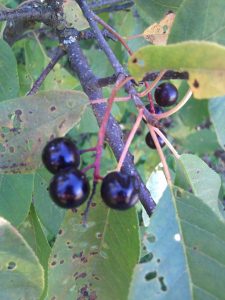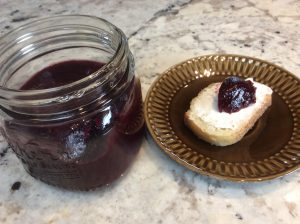Chokecherries
Years ago when I was teaching in Hazelton (Gitksan territory), I remember children coming to school in the fall with mouths all purple from eating the chokecherries that grew on the paths to school. I tried one then and realized why they got the name. They are known for their astringency. The Gitksan name for choke cherry means “it makes your mouth and throat so that nothing will slip on it” which is a very apt description of the choking sensation that it can evoke. Despite this, Aboriginal people in the southern and northern Interior ate the chokecherry fruit. They collected the cherries in the fall and dried them, often with the stones left in. [i]
Chokecherries (Prunus virginiana) are a member of the rose family and found throughout Canada and the US. ‘Virginiana’ refers to the area where chokecherries were first identified and described. They are common in southern British Columbia, especially east of the Coast and Cascade mountains, in central and northeastern BC, and the Peace and Stikine river valleys. They typically grow on the edge of woodlands and thickets, often on dry, exposed sites, along streams and in clearings[ii].
The chokecherry is a shrub-like tree that sometimes has a twisted or crooked trunk. The wood was traditionally use for handles and the bark was shredded for decorating baskets and as a twine. They bloom in the spring with clusters of small five-petalled white flowers appearing at the end of each twig. The fruits ranging from red to black appear later and ripen in late summer and early fall. Modern uses of the cherries include wine, juice, syrup, jelly and jam[iii]. Usually it is recommended that the seeds be removed because chokecherry stones release a harmful substance called hydrocyanic acid into the stomach and consuming too many will make you ill.[iv]
On a recent visit to Hazelton I found a chokecherry tree at the back of my mother-in-law’s property. It was rather late in the season but I was able to pick enough for one small jar of chokecherry jelly. Being late in the season is supposed to be better as when they are dark purple-black, showing no hint of red and over-ripened, they taste better than ones collected as soon as they darken, as their astringency is greatly reduced.[v]
This is the recipe I used, directions slightly modified from the original source[vi]. I used the honey variation as it is a BC Sweetener[vii]. I chose to use Pomona’s Universal Pectin™ since you can develop your own recipes where the amount of pectin used is based on the amount of fruit juice and you are able to halve, quarter, double or triple the recipes. In my case from my meagre picking I was only able to get 1 cup of juice, so I had to quarter the recipe. I didn’t bother to process because I was going to consume it right away.
Chokecherry Jelly Recipe
- 4 cups of chokecherry juice
- 1/4 cup of lemon juice
- 1 1/2 to 2 cups of sugar OR 1 1/2 cups honey
- 4 teaspoons of Pomona’s Universal Pectin™
- 4 teaspoons of calcium water (this comes with Pomona’s Universal Pectin™)
- Prepare jars by washing and holding in hot water until needed. Prepare the lids according to package directions.
- Clean and wash berries, place in a large pot and fill with enough water to just cover the fruit. Simmer for 15-30 minutes or until the fruit softens. Mash with a potato masher to extract the juice. Strain through a jelly bag or a cheesecloth-lined colander or sieve. Save the juice and discard the pulp/pits.
- 3.Thoroughly mix the sugar or honey in a separate bowl with the Pomona’s Universal Pectin.
- Mix the chokecherry juice, lemon juice, and calcium water in a pot and bring to a boil. When boiling add the pectin/sweetener mixture and allow it to come back to a full rolling boil. Remove from heat.
- Fill the jars leaving ¼” head space. Add lids and rings and process in a boiling water bath canner for 10 minutes (add an extra minute for every 1000 feet you are above sea level).
[i] https://www.for.gov.bc.ca/hfd/library/documents/treebook/chokecherry.htm
[ii] https://www.for.gov.bc.ca/hfd/library/documents/treebook/chokecherry.htm
[iii] http://www.bcadventure.com/adventure/wilderness/forest/chokechr.htm
[iv] http://www.homefamily.net/2011/07/16/how-to-use-chokecherries/
[v] https://preparednessadvice.com/survival/chokecherries-an-edible-fruit/
[vi] https://www.theprairiehomestead.com/2012/08/how-to-make-chokecherry-jelly-low-sugar-and-honey-variations.html
[vii] https://www.bcaitc.ca/resources/bc-honey-natural-sweetener


